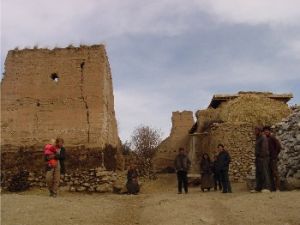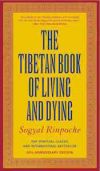「Sogyal Rinpoche 索甲仁波切」修訂間的差異
SSTC Bubble(對話 | 貢獻) 小 (已匯入 1 筆修訂) |
SSTC Natalie(對話 | 貢獻) (新增普賢臉書分享連結) |
||
| (未顯示由 1 位使用者於中間所作的 3 次修訂) | |||
| 行 1: | 行 1: | ||
[[Image:SR LL 2006.JPG|thumb|Sogyal Rinpoche teaching in [[Lerab Ling]]]] | [[Image:SR LL 2006.JPG|thumb|Sogyal Rinpoche teaching in [[Lerab Ling]]]] | ||
'''Sogyal Rinpoche''' (Tib. བསོད་རྒྱལ་རིན་པོ་ཆེ་, [[Wyl.]] ''bsod rgyal rin po che'') — Born into the [[Lakar family]] in [[Kham]] in Eastern Tibet, Sogyal Rinpoche was recognized as the incarnation of Lerab Lingpa [[Tertön Sogyal]], a teacher to the [[Thirteenth Dalai Lama]], by [[Jamyang Khyentse Chökyi Lodrö]], one of the most outstanding spiritual masters of the twentieth century. Jamyang Khyentse supervised Rinpoche's training and raised him like his own son. | '''Sogyal Rinpoche''' (Tib. བསོད་རྒྱལ་རིན་པོ་ཆེ་, [[Wyl.]] ''bsod rgyal rin po che'') — Born into the [[Lakar family]] in [[Kham]] in Eastern Tibet, Sogyal Rinpoche was recognized as the incarnation of Lerab Lingpa [[Tertön Sogyal]], a teacher to the [[Thirteenth Dalai Lama]], by [[Jamyang Khyentse Chökyi Lodrö]], one of the most outstanding spiritual masters of the twentieth century. Jamyang Khyentse supervised Rinpoche's training and raised him like his own son. | ||
| + | |||
| + | 索甲仁波切出生於西藏東部康巴的拉卡家族,由二十世紀最傑出的靈性大師之一蔣揚.欽哲.確吉.羅卓,認證為伏藏師索甲.雷瑞.林巴(十三世達賴喇嘛的老師之一)的轉世。蔣揚.欽哲指導仁波切的修學,並視如己出地養育他。 | ||
In 1971, Rinpoche went to England where he received a Western education, studying Comparative Religion at Cambridge University. He went on to study with many other great masters, of all [[four schools|schools of Tibetan Buddhism]], including [[Dudjom Rinpoche]], [[Dilgo Khyentse Rinpoche]] and [[Nyoshul Khen Rinpoche]], serving as their translator and aide. | In 1971, Rinpoche went to England where he received a Western education, studying Comparative Religion at Cambridge University. He went on to study with many other great masters, of all [[four schools|schools of Tibetan Buddhism]], including [[Dudjom Rinpoche]], [[Dilgo Khyentse Rinpoche]] and [[Nyoshul Khen Rinpoche]], serving as their translator and aide. | ||
| + | |||
| + | 仁波切在1971年到達英國,並在那裡接受西方教育,於劍橋大學主修比較宗教學。此後他向很多其他各派偉大的藏傳佛教傳承大師們學習,包括敦珠仁波切,頂果.欽哲仁波切以及紐修堪仁波切,擔任他們的翻譯以及助手。 | ||
With his remarkable gift for presenting the essence of [[Tibetan Buddhism]] in a way that is both authentic and profoundly relevant to the modern mind, Sogyal Rinpoche is one of the most renowned teachers of our time. He is also the author of the highly-acclaimed and ground breaking book, ''[[The Tibetan Book of Living and Dying]]''. Two million copies of this spiritual classic have been sold in 29 languages and 56 countries. It has been adopted by colleges, groups and institutions, both medical and religious, and is used extensively by nurses, doctors and health care professionals. | With his remarkable gift for presenting the essence of [[Tibetan Buddhism]] in a way that is both authentic and profoundly relevant to the modern mind, Sogyal Rinpoche is one of the most renowned teachers of our time. He is also the author of the highly-acclaimed and ground breaking book, ''[[The Tibetan Book of Living and Dying]]''. Two million copies of this spiritual classic have been sold in 29 languages and 56 countries. It has been adopted by colleges, groups and institutions, both medical and religious, and is used extensively by nurses, doctors and health care professionals. | ||
| + | |||
| + | 索甲仁波切以其能真實且深刻地將藏傳佛教精髓呈現給現代[人們]心靈的卓越天賦,而成為當代最負盛名的導師之一。他也是那本受到高度讚譽且富有開創性的《西藏生死書》之作者。這本心靈經典被翻譯成29種語言,在56個國家發行了兩百萬份。此書受到包括醫療和宗教方面的學院、團體和機構所採用,並廣受護士、醫生和醫護專業人員所運用。 | ||
Rinpoche is also the founder and spiritual director of [[About Rigpa|Rigpa]], an international network of 130 centres and groups in 41 countries around the world. He has been teaching for over 30 years and continues to travel widely in Europe, America, Australia, and Asia, addressing thousands of people on his retreats and teaching tours. | Rinpoche is also the founder and spiritual director of [[About Rigpa|Rigpa]], an international network of 130 centres and groups in 41 countries around the world. He has been teaching for over 30 years and continues to travel widely in Europe, America, Australia, and Asia, addressing thousands of people on his retreats and teaching tours. | ||
| + | |||
| + | 仁波切也是Rigpa(本覺會)的創始人和精神領袖,這個國際網絡在世界41個國家具有130多個中心和團體。他傳法已超過30年,並持續走訪於歐洲、美國、澳洲以及亞洲各處,在他的隱居期間以及教學之旅中,都給予成千上萬人們開示。 | ||
| + | |||
| + | 臉書連結:[https://www.facebook.com/GlimpseFromDharmaOcean/posts/2910820382321645 索甲仁波切(Sogyal Rinpoche)] | ||
==Biography== | ==Biography== | ||
| 行 110: | 行 120: | ||
| − | [ | + | |
| + | ==Rigpa Wiki== | ||
| + | [http://www.rigpawiki.org/index.php?title=Sogyal_Rinpoche Sogyal Rinpoche] | ||
| + | |||
| + | {{翻譯聲明}} | ||
| + | |||
| + | |||
| + | |||
[[Category:Contemporary Teachers]] | [[Category:Contemporary Teachers]] | ||
| − | [[Category: | + | [[Category:Contemporary Teachers 當代108位藏密上師]] |
| − | [[Category:Longchen Nyingtik Teachers]] | + | [[Category:Lakar Family 拉卡家族]] |
| − | [[Category:Rimé Teachers]] | + | [[Category:Longchen Nyingtik Teachers 龍欽心髓上師]] |
| − | [[Category: | + | [[Category:Nyingma Teachers 寧瑪教派上師]] |
| + | [[Category:Rimé Teachers 不分教派上師]] | ||
| + | [[category:Sogyal Rinpoche 索甲仁波切]] | ||
| + | |||
| + | [[Category:中譯]] | ||
於 2021年3月29日 (一) 12:34 的最新修訂
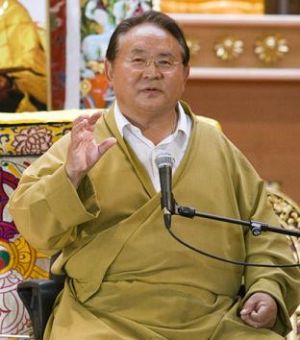
Sogyal Rinpoche (Tib. བསོད་རྒྱལ་རིན་པོ་ཆེ་, Wyl. bsod rgyal rin po che) — Born into the Lakar family in Kham in Eastern Tibet, Sogyal Rinpoche was recognized as the incarnation of Lerab Lingpa Tertön Sogyal, a teacher to the Thirteenth Dalai Lama, by Jamyang Khyentse Chökyi Lodrö, one of the most outstanding spiritual masters of the twentieth century. Jamyang Khyentse supervised Rinpoche's training and raised him like his own son.
索甲仁波切出生於西藏東部康巴的拉卡家族,由二十世紀最傑出的靈性大師之一蔣揚.欽哲.確吉.羅卓,認證為伏藏師索甲.雷瑞.林巴(十三世達賴喇嘛的老師之一)的轉世。蔣揚.欽哲指導仁波切的修學,並視如己出地養育他。
In 1971, Rinpoche went to England where he received a Western education, studying Comparative Religion at Cambridge University. He went on to study with many other great masters, of all schools of Tibetan Buddhism, including Dudjom Rinpoche, Dilgo Khyentse Rinpoche and Nyoshul Khen Rinpoche, serving as their translator and aide.
仁波切在1971年到達英國,並在那裡接受西方教育,於劍橋大學主修比較宗教學。此後他向很多其他各派偉大的藏傳佛教傳承大師們學習,包括敦珠仁波切,頂果.欽哲仁波切以及紐修堪仁波切,擔任他們的翻譯以及助手。
With his remarkable gift for presenting the essence of Tibetan Buddhism in a way that is both authentic and profoundly relevant to the modern mind, Sogyal Rinpoche is one of the most renowned teachers of our time. He is also the author of the highly-acclaimed and ground breaking book, The Tibetan Book of Living and Dying. Two million copies of this spiritual classic have been sold in 29 languages and 56 countries. It has been adopted by colleges, groups and institutions, both medical and religious, and is used extensively by nurses, doctors and health care professionals.
索甲仁波切以其能真實且深刻地將藏傳佛教精髓呈現給現代[人們]心靈的卓越天賦,而成為當代最負盛名的導師之一。他也是那本受到高度讚譽且富有開創性的《西藏生死書》之作者。這本心靈經典被翻譯成29種語言,在56個國家發行了兩百萬份。此書受到包括醫療和宗教方面的學院、團體和機構所採用,並廣受護士、醫生和醫護專業人員所運用。
Rinpoche is also the founder and spiritual director of Rigpa, an international network of 130 centres and groups in 41 countries around the world. He has been teaching for over 30 years and continues to travel widely in Europe, America, Australia, and Asia, addressing thousands of people on his retreats and teaching tours.
仁波切也是Rigpa(本覺會)的創始人和精神領袖,這個國際網絡在世界41個國家具有130多個中心和團體。他傳法已超過30年,並持續走訪於歐洲、美國、澳洲以及亞洲各處,在他的隱居期間以及教學之旅中,都給予成千上萬人們開示。
目錄
Biography
Birth and Early Life
Sogyal Rinpoche was born into the Lakar family of Trehor, Kham in Eastern Tibet in the Fire Pig year (1947-8). His father was Jamga, a nephew of Dilgo Khyentse Rinpoche, and his mother, Mayum Tsering Wangmo of the Lakar family, was recognized as an emanation of Ushnishavijaya by Khenpo Ngakchung.
Mayum Tsering Wangmo remembers:
- "At his birth, there were many wonderful signs, such as rainbows arching over the roof of the house, and on that auspicious day there was not the slightest problem of any kind."
He was delivered by Ratak Sogyal, the brother of Kalu Rinpoche. Only six months later, the young child was invited to see Jamyang Khyentse Chökyi Lodrö at Dzongsar, the seat of the Khyentses. Whilst on the way, his father Jamga and mother Tsering Wangmo, as well as Ani Pema Lhamo, the male servant Tsering Pépé, the female servant Apé Lhadzom and many others heard him utter his very first words as he recited the vajra guru mantra aloud three times.
Khyentse Rinpoche invited the party to join him for a special meal on an auspicious date, and when they went in to see him, everything had been prepared for an enthronement ceremony. As soon as Ani-la saw what was intended, she was amazed and said aloud, “What are you doing? He is the family’s only son. He can not be given away to anyone.” In response, Khyentse Rinpoche wrote a statement in his own hand, in which he clearly identified the boy as a genuine incarnation of Tertön Sogyal."
He was also recognized as an incarnation of several other masters, including Do Khyentse Yeshe Dorje, Lingtsang Gyalpo and Desi Sangye Gyatso.
Mayum Tsering Wangmo remembers:
- "On another occasion, when the family were in Hor, the young Sogyal tulku took three phurbas from under the carpet while he played in his room. His mother and father tried many times to discover whose they were, but noone claimed them, and they became objects of worship. Once, when he was playing in the Guru Rinpoche temple, he was heard shouting, “Come quickly! Guru Rinpoche is standing up!” But before anyone could get there, the Guru Rinpoche statue had sat back down again. The first to arrive later remarked how he had seen Guru Rinpoche’s khatvanga trident still rattling.
- Sogyal Tulku’s games were not like those of other children. For toys, he would use the ritual instruments from the monastery, and everyone observed how he was always well-mannered and polite."
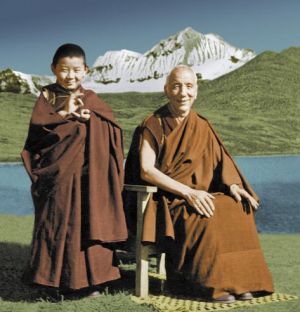
According to Dzongsar Ngari Tulku (Tenzin Khedrup Gyatso), on one occasion [c.1952], when Jamyang Khyentse Chökyi Lodrö was opening the sacred place of Khyungchen Paldzong (Tib. ཁྱུང་ཆེན་དཔལ་རྫོང་, khyung chen dpal rdzong), known locally as Gyalgen Khyungtak (Tib. རྒྱ་རྒན་ཁྱུང་ལྟག་rgya rgan khyung ltag), above Dzongsar Monastery, Jamyang Khyentse, Gyarong Khandro, Khandro Tsering Chödrön and Sogyal Rinpoche all left their handprints in the solid rock.
In 1955, Sogyal Rinpoche left Kham, together with his family, Jamyang Khyentse Chökyi Lodrö and around fifty other people, and travelled to Central Tibet. They met the Dalai Lama at the Potala in Lhasa.[1] While in Lhasa, they stayed at the Samdrup Podrang.
In 1956 they visited Tsurphu, Mindroling, Samye Chimphu and Lhodrak, where Jamyang Khyentse introduced the young Sogyal Tulku to the nature of mind.
At the end of 1956, they arrived in India, and visited Tso Pema and Bodhgaya. In 1957, they stayed mostly in Sikkim, at the Palace Monastery in Gangtok. They once again visited Bodhgaya and Varanasi, where they met the Dalai Lama. In 1958, they spent the summer in Darjeeling, staying at Kuch Behar at the Maharaj's palace.
Jamyang Khyentse Chökyi Lodrö passed away in Gangtok on the sixth day of the fifth Tibetan month in the Earth Pig year (1959).
Mayum Tsering Wangmo remembers:
- "As he was passing away in Sikkim, Khyentse Rinpoche gave instructions that Khenpo Appey should take charge of Sogyal Tulku’s education. When studying with Khenpo Appey, the young Sogyal was always at the head of his class, and came first or second in examinations taken with many other lamas and tulkus."
He also studied with Khenpo Lodrö Zangpo and Gyaltön Rinpoche at this time, and learned Tibetan calligraphy from Drungyik Tsering Tashi.
Mayum Tsering Wangmo remembers:
- "Later, when he attended school [in Kalimpong], he outperformed the other children to such a degree that he used to complete two years’ classes in a single year! Not only that, as he felt compassion and concern for his parents, he chose not to sleep at the school, and when his teachers asked him why he could not stay on the school premises, he replied that his parents were having difficulties, because they had no less than fifty-five old lamas in their care.
- At one point, the children were told that an important foreign guest would be visiting their school in a few days, and that to mark the occasion they each had to write a special essay. Rinpoche wrote something, which was read by the guest, who immediately asked after its author. “He is a boy in class five,” he was told. The guest was amazed: “Impossible! A child in class five could never write something like this,” he said. “Bring him here!” When Rinpoche arrived, they talked for a while and the guest went away most impressed. He later became Rinpoche’s sponsor.
- After he finished school, Rinpoche accompanied the Prince of Sikkim to college in Delhi, and afterwards to England, where he studied at Cambridge, and gained an unrivalled knowledge of the religious traditions in the East and West."
In the West
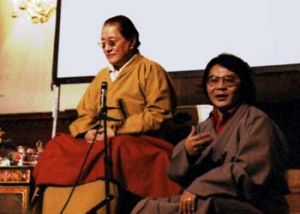
- In 1971, Rinpoche went to England where he received a Western education, studying Comparative Religion at Cambridge University. He went on to study with many other great masters, of all schools of Tibetan Buddhism, including Dudjom Rinpoche, Dilgo Khyentse Rinpoche and Nyoshul Khen Rinpoche, serving as their translator and aide.
- In 1973 he welcomed His Holiness the Dalai Lama on his first trip to Europe, and accompanied him when he travelled to Italy and the Vatican where they met Pope Paul VI, and to Switzerland, Holland, Belgium, Ireland, Norway, Sweden, Denmark and the United Kingdom. [check!!]
- In 1974, he began teaching publicly. He also translated for Rahor Khenpo Tupten at Marilyn Silverstone’s house in London
- In 1975 he taught two or three evenings a week in a private flat in Swiss Cottage. Between January and April he taught on meditation, the history of Buddhism, the teaching of the Buddha, and Tibetan language. The emerging group moved to premises in Chatsworth Road at the end of May.
- August 27th 1977 saw the Opening Ceremony for the Orgyen Chö Ling Centre in Kilburn, London. It was visited by His Holiness the Karmapa and Jamgon Kongtrul Rinpoche in November.
- September 28th 1978 saw the French sangha's first meeting at its centre in Rue Burq, Paris.
- In 1982, he requested and organized the teachings given in Paris by His Holiness the Dalai Lama at the Pagode de Vincennes.
- In 1989, Rigpa organized the historic teachings given by His Holiness the Dalai Lama at San Jose, and Sogyal Rinpoche gave the welcome address, congratulating His Holiness for being awarded the Nobel Peace Prize. He also served as a translator during the teachings.
- In August 1990, Sogyal Rinpoche and Rigpa hosted Dilgo Khyentse Rinpoche on his final visit to the West, together with an extraordinary gathering of masters at Prapoutel, a ski resort in the French Alps.
- In 1991, he founded the retreat centre of Lerab Ling near Montpellier in southern France.
- In 1992, The Tibetan Book of Living and Dying was published. Two million copies of this spiritual classic have been sold in 29 languages and 56 countries. It has been adopted by colleges, groups and institutions, both medical and religious, and is used extensively by nurses, doctors and health care professionals.
- In 1993, he appeared in Bernardo Bertolucci's film Little Buddha in the role of Khenpo Tenzin.
- In 2000, he welcomed His Holiness the Dalai Lama to Lerab Ling (see Lerab Gar 2000).
- In 2008, he welcomed His Holiness the Dalai Lama again to Lerab Ling. The Dalai Lama consecrated the Palri Pema Ösel Dargyé Ling temple and its main Buddha statue.
Publications
- Sogyal Rinpoche, Dzogchen and Padmasambhava; ISBN 0962488402
- Sogyal Rinpoche, The Tibetan Book of Living and Dying; ISBN 0062508342
- Sogyal Rinpoche, The Future of Buddhism (contains 'The Future of Buddhism', 'The Spiritual Heart of Tibetan Medicine', 'View and Wrong View' & 'Being on Top of Things'), Rider, 2002, ISBN 0712615644
- Sogyal Rinpoche, Glimpse After Glimpse: Daily Reflections on Living and Dying; ISBN 0062511262
Further Reading
- Nyoshul Khenpo, A Marvelous Garland of Rare Gems: Biographies of Masters of Awareness in the Dzogchen Lineage (Junction City: Padma Publications, 2005), '15. The Students of Jamyang Khyentsé Chökyi Lodrö and Other Masters', Lakar Sogyal Choktrul Rinpoché, pages 462-463.
References & Notes
- ↑ Sogyal Rinpoche describes in some detail his first encounter with the Dalai Lama in his foreword to the book Dzogchen: The Heart Essence of the Great Perfection, by His Holiness the Dalai Lama, Snow Lion Publications, 2000.
Internal Links
External Links
- Sogyal Rinpoche website
- The Tibetan Blog of Living and Dying
- Main Rigpa Website
- Lerab Ling Website
 History of the Lakar Family
History of the Lakar Family- Rigpa News
 Sogyal Rinpoche Series on Lotsawa House
Sogyal Rinpoche Series on Lotsawa House
Rigpa Wiki
""Decode Wiki"" hereby provides the Chinese translation of certain contents from ""Rigpa Wiki"" with permission for all readers and free of charge, however, does not serve as its official translation. Suggestions and corrections are highly appreciated.
「解密維基」經「本覺維基」同意將其網站內容進行中譯並提供讀者免費參照,但非該網之官方中譯。敬請各方不吝指教。
